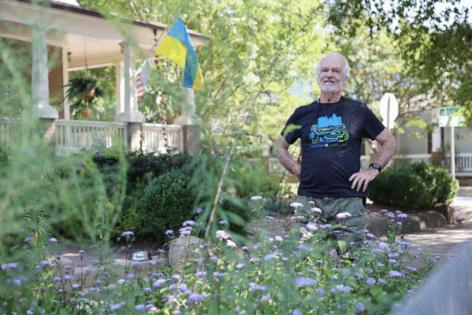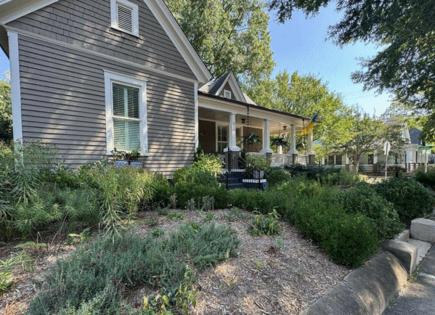They tried to restore nature to growing city -- and got citations for it
Published in Science & Technology News
CHARLOTTE, N.C. -- Lou Lesesne has spent years cultivating a naturalistic garden in his front yard.
He uses only native species of plants and allows them to grow tall, flower and seed without regular mowing. It’s an approach that has gained in popularity as cities adopt friendlier laws recognizing potential environmental benefits of creating natural habitats over manicured grass lawns.
“I like the idea of it being consistent with nature, giving food to birds and insects,” Lesesne said. “The other side of that coin is, there’s a lot of pollution that comes from chemicals people put on their lawns and the amount of water they consume.”
Charlotte is not one of those native garden-friendly cities — at least, not yet.
Lesesne received a violation letter in the mail in June saying his yard was overgrown. Vegetation cannot grow taller than 1 foot under city law or else a resident can face penalty fees up to $500.
He had seven days to correct the violation, the letter said. Otherwise, the city could hire a contractor to cut back the vegetation at Lesesne’s expense or cite him for a misdemeanor.
The North Carolina Wildlife Federation has received a wave of calls from residents upset about citations, said Alden Picard, the federation’s conservation coordinator. From their frustration blossomed a multi-organizational effort to amend Charlotte’s vegetation ordinance that, if successful, could codify protections for native plant gardens.
The group of advocates, dubbed the Coalition to Protect our Urban Nature in Charlotte, held its first meeting in July with representatives from the wildlife federation, NC Native Plant Society, Charlotte Mecklenburg League of Women’s Voters and other organizations. They’ve since spoken at City Council meetings and sent hundreds of emails to council members.
“I’ve had people knock on our office doors up in arms,” Picard said. “It just came to a point where, it was time. There was enough of an impetus, there was enough energy there. Let’s get people on a call, and let’s see what happens.”
Why some Charlotteans want native plant gardens
Elaine Alexander thinks of her small Dilworth yard as a classroom.
Passersby pause to take in the beauty of her native plants or offer a compliment, and children, mouths agape and fingers pointing, marvel at the buzzing inhabitants. Alexander tells them all about the plants she’s chosen.
She’s formally studying garden design in hopes she can create pollinator habitats for others, too, she said. She wants everybody in Charlotte to experience this joy without fear of penalty.
“I’ve just been overwhelmed by the beauty of seeing so many hummingbirds, and butterflies, and native bees, and it’s just wonderful,” Alexander said. “It’s like every morning I wake up, and I see the wonders of nature.”
Sarah Gagne understands the importance of a vegetation ordinance, she said. Gagne is an associate professor of urban ecology at UNC Charlotte and the chair of the department of earth, environmental and geographical sciences.
There should be a mechanism to maintain health and sanitation standards in the city, she said. But a distinction must be made between residents who are intentionally cultivating a native garden versus abandoned homes or those who habitually put off mowing their lawns.
“What we’re asking is if you can demonstrate there are cues to care — somebody is caring for the vegetation — that you can have leeway in creating naturalistic landscapes,” Gagne said.
By some measures, Charlotte is considered an environmentally conscious city. The National Wildlife Federation certified it as a community wildlife habitat in 2015, making it the largest city east of the Mississippi to receive the designation at the time. More than 900 properties across the city contributed to the honor and were celebrated for the same characteristics that can lead to a citation under the vegetation ordinance.
In 2023, City Council passed a resolution designating Charlotte a “Bee City” affiliate. The move represented a commitment to supporting pollinators and enhancing their habitats, according to the city.
That’s why the ordinance doesn’t make much sense to at-large Councilwoman Dimple Ajmera. She agreed to support the coalition’s cause after they met with her.
“Charlotte has pledged to protect pollinators and champion sustainability, yet our outdated vegetation ordinance punishes residents who create the very habitats our city needs,” Ajmera said in a written statement to The Charlotte Observer. “Updating this law is common-sense stewardship—supporting pollinators, reducing runoff, and aligning our code with Charlotte’s own environmental commitments.”
The city already has a process where citizens can register their naturalistic landscapes for protection. Registered properties are not subject to code violations if maintained, the city said in a written response to the Observer.
If a property owner is not registered and receives a violation notice, they have 30 days to register to avoid penalties.
That process is not good enough, Picard said. Unlike other cities, the registration is not codified in Charlotte ordinance, meaning the city is not legally bound to honor it.
The registration is overseen by a division whose authority is over city-owned properties, not private properties, Picard said. Plus, most people don’t even know they have an option to register because information is not easily accessible, he said. Violation notices don’t mention the option, either.
City staff are currently looking into registration improvements based on stakeholder feedback, the city told the Observer. The mayor and council have not taken any steps to amend the ordinance.
Mecklenburg County species are in decline due to habitat loss, experts say
Bird species have declined in Mecklenburg County for various reasons, said longtime Mecklenburg Audubon Society leader Judy Walker. Some declines relate closely to the actions of property owners.
The red-headed woodpecker is in decline due to the removal of old trees that provided nesting holes, Walker said.
The eastern meadowlark requires open fields for feeding and nesting. Those fields are quickly disappearing, save for “a few places” in northern Mecklenburg.
And common nighthawks and chimney sweeps, both aerial insectivores, have seen dramatic changes in habitat and diet availability. Spraying weeds and mosquitoes “decimated” the insect population they rely on for food, Walker said, and most large, open chimneys have been removed or capped.
“I realize this doesn’t appear to be directly connected to plants in our yards, but you have to realize native plants, especially trees, are the foundation of the food chain,” Walker said. “They provide food for insects, which in turn provide food for the birds as 99% of all birds in our area need insects to feed their young.”
Gagne flagged other troubling data trends. A 2019 study found North America has lost 3 billion birds since 1970. And a report published this year showed a 22% drop in butterflies in the United States compared to two decades ago. That same study suggests about 70% of the butterfly species native to Charlotte are in decline.
“Our idea of a yard is a lawn, so we’re replacing any vegetation or habitat that was there before with this human construct of what we think nature should look like, which is very species poor. It requires a lot of resources to maintain, like pesticides and water and fertilizer,” Gagne said. “We’ve wiped out a lot of habitat. But the thing that I find exciting about urban ecology is that we design our cities, so we can design them differently.”
How cities are changing their vegetation laws
If Charlotte moves forward with an amendment, it wouldn’t be the first city in the region to change its vegetation laws.
Columbia, South Carolina, deems grass and overgrowth vegetation to be a nuisance if it’s higher than 12 inches. In 2024, Columbia amended its ordinance to exempt planned and managed naturalistic landscapes, citing environmental benefits.
The city encourages residents to have their gardens certified by reputable organizations like the Wildlife Federation and post signs verifying compliance with those organizations’ standards.
Winston-Salem passed a similar ordinance last year that allows native vegetation to grow higher than 8 inches and reduces the minimum required distance between landscaping and property lines from 20 feet to 5 feet.
Moriah Gendy, who works with Winston-Salem’s office of sustainability, told WFDD the change sprouted from citizen complaints. The ordinance helps people save money and could benefit the city from an environmental standpoint, Gendy told the NPR affiliate.
Residents must register their natural gardens with Winston-Salem and submit a plan including details such as plant species and maintenance schedule, according to the city. Registration is free but subject to revocation if a yard is not properly maintained. Natural landscape areas visible to the public must also display an identifying sign.
©2025 The Charlotte Observer. Visit charlotteobserver.com. Distributed by Tribune Content Agency, LLC. ©2025 The Charlotte Observer. Visit at charlotteobserver.com. Distributed by Tribune Content Agency, LLC.










Comments